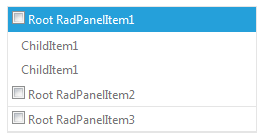Adding Templates at Runtime
Templates could be added to RadPanelBar at runtime, using the ItemTemplate, ContentTemplate and HeaderTemplate properties. All of them are of type ITemplate, so you must assign an object that implements that interface as a value.
The RadPanelBar items should be dynamically added so that templates can be defined at run time. Also, the items should be bound to be able to eval DataBinder expressions. In other words, you should call the DataBind method of the RadPanelBar object or bind the items that are about to use DataBinder.Eval . You can bind a specific item by calling the DataBind method of this specific item.
The ItemTemplate/ContentTemplate should be initialized in the OnInit event of the page. This is needed as the template should be instantiated before the RadPanelBar items are initialized.
Item Template
The example below shows how to add Item Templates at run-time.
protected override void OnInit(EventArgs e)
{
RadPanelBar1.ItemTemplate = new TextBoxTemplate(); base.OnInit(e);
}
protected void Page_Load(object sender, EventArgs e)
{
if (!Page.IsPostBack)
{
RadPanelBar1.Items.Add(new RadPanelItem("PanelItem1"));
RadPanelBar1.Items.Add(new RadPanelItem("PanelItem2"));
}
RadPanelBar1.DataBind();
}
class TextBoxTemplate : ITemplate
{
public void InstantiateIn(Control container)
{
Label label1 = new Label();
label1.ID = "ItemLabel";
label1.Text = "Text";
label1.Font.Size = 15;
label1.Font.Bold = true;
label1.DataBinding += new EventHandler(label1_DataBinding);
container.Controls.Add(label1);
}
private void label1_DataBinding(object sender, EventArgs e)
{
Label target = (Label)sender;
RadPanelItem item = (RadPanelItem)target.BindingContainer;
string itemText = (string)DataBinder.Eval(item, "Text"); target.Text = itemText;
}
}
If you for some reason cannot define the template in the OnInit event of the page, you could use another approach:
The template has to be instantiated for each item upon a postback. Since the TextBoxTemplate class initializes the label on InstantiateIn we called the InstantiateIn method of the TextBoxTemplate object for each item.
protected void Page_Load(object sender, EventArgs e)
{
if (!Page.IsPostBack)
{
RadPanelBar1.Items.Add(new RadPanelItem("PanelItem1"));
RadPanelBar1.Items.Add(new RadPanelItem("PanelItem2"));
}
TextBoxTemplate template = new TextBoxTemplate();
foreach (RadPanelItem item in RadPanelBar1.GetAllItems())
{
template.InstantiateIn(item);
}
RadPanelBar1.DataBind();
}
The end result of this code looks like the following:

Content Template
Here is also an example that uses a Content Template at run-time.
<telerik:RadPanelBar RenderMode="Lightweight" ID="RadPanelBar1" runat="server">
<Items>
<telerik:RadPanelItem runat="server" Text="Root RadPanelItem1" Value="A">
</telerik:RadPanelItem>
<telerik:RadPanelItem runat="server" Text="Root RadPanelItem2" Value="B">
</telerik:RadPanelItem>
<telerik:RadPanelItem runat="server" Text="Root RadPanelItem3" Value="C">
</telerik:RadPanelItem>
</Items>
</telerik:RadPanelBar>
protected void Page_Load(object sender, EventArgs e)
{
CustomContentTemplate template = new CustomContentTemplate();
foreach (RadPanelItem item in RadPanelBar1.Items)
{
item.ContentTemplate = new CustomContentTemplate();
template.InstantiateIn(item);
item.DataBind();
}
}
Here is the class for the Content Template that is used in the PageLoad
class CustomContentTemplate : ITemplate
{
public void InstantiateIn(Control container)
{
Label label1 = new Label();
label1.Font.Bold = true;
label1.DataBinding += new EventHandler(label1_DataBinding);
container.Controls.Add(label1);
}
private void label1_DataBinding(object sender, EventArgs e)
{
Label target = (Label)sender;
RadPanelItem item = (RadPanelItem)target.BindingContainer;
target.Text = item.Value;
//Alternative way:
//string itemText = (string)DataBinder.Eval(item, "Value"); target.Text = itemText;
}
}
Header Template
The dynamic creation of Header Template is a bit different that the one of the Item and Content templates. Once the HeaderTemplate property is set, the ApplyHeaderTemplate method should be invoked in order to apply and instantiate the template.
Here is also an example that uses a Header Template at run-time.
<telerik:RadPanelBar RenderMode="Lightweight" ID="RadPanelBar1" runat="server" Skin="Metro">
<Items>
<telerik:RadPanelItem runat="server" Text="Root RadPanelItem1" Value="A" Expanded="true">
<Items>
<telerik:RadPanelItem Text="ChildItem1" runat="server">
</telerik:RadPanelItem>
<telerik:RadPanelItem Text="ChildItem1" runat="server">
</telerik:RadPanelItem>
</Items>
</telerik:RadPanelItem>
<telerik:RadPanelItem runat="server" Text="Root RadPanelItem2" Value="B">
</telerik:RadPanelItem>
<telerik:RadPanelItem runat="server" Text="Root RadPanelItem3" Value="C">
</telerik:RadPanelItem>
</Items>
</telerik:RadPanelBar>
protected void Page_Load(object sender, EventArgs e)
{
foreach (RadPanelItem item in RadPanelBar1.Items)
{
item.HeaderTemplate = new HeaderTemplateClass();
item.ApplyHeaderTemplate();
item.DataBind();
}
}
Here is the class for the Header Template that is used in the PageLoad
class HeaderTemplateClass : ITemplate
{
public void InstantiateIn(Control container)
{
CheckBox HeaderCheckBox = new CheckBox();
HeaderCheckBox.DataBinding += new EventHandler(HeaderCheckBox_DataBinding);
container.Controls.Add(HeaderCheckBox);
}
protected void HeaderCheckBox_DataBinding(object sender, EventArgs e)
{
CheckBox target = (CheckBox)sender;
RadPanelItem item = (RadPanelItem)target.BindingContainer.NamingContainer;
target.Text = item.Text;
}
}
The end result of this code looks like the following:
